The British Expeditionary Force (BEF) was the six divisions the British Army sent to the Western Front during the First World War. Planning for a British Expeditionary Force began with the 1906–1912 Haldane Reforms of the British Army carried out by the Secretary of State for War Richard Haldane following the Second Boer War (1899–1902).

The King's African Rifles (KAR) was a British Colonial Auxiliary Forces regiment raised from Britain's East African colonies in 1902. It primarily carried out internal security duties within these colonies along with military service elsewhere during the world wars and other conflicts, such as the Malayan Emergency and the Mau Mau uprising. The regiment's enlisted soldiers were drawn from the native Africans, while most officers were seconded from the British Army. During the 1960s, as part of the decolonisation of Africa, more African officers were commissioned into the regiment before it was gradually disbanded. KAR battalions would go on to form the core of newly established armed forces throughout East Africa.

The First Australian Imperial Force was the main expeditionary force of the Australian Army during the First World War. It was formed as the Australian Imperial Force (AIF) following Britain's declaration of war on Germany on 15 August 1914, with an initial strength of one infantry division and one light horse brigade. The infantry division subsequently fought at Gallipoli between April and December 1915, with a newly raised second division, as well as three light horse brigades, reinforcing the committed units.

SSMendi was a British 4,230 GRT passenger steamship that was built in 1905 and, as a troopship, sank after collision with great loss of life in 1917.

The No. 2 Construction Battalion, Canadian Expeditionary Force (CEF), was raised in Nova Scotia and was one of two predominantly Black battalions in Canadian military history and the only Canadian battalion composed of Black soldiers to serve in World War I. Commanded by Lieutenant Colonel Daniel Hugh Sutherland, formerly of the 193rd Battalion, CEF.

The West India Regiments (WIR) were infantry units of the British Army recruited from and normally stationed in the British colonies of the Caribbean between 1795 and 1927. In 1888 the two West India Regiments then in existence were reduced to a single unit of two battalions. This regiment differed from similar forces raised in other parts of the British Empire in that it formed an integral part of the regular British Army. In 1958 a new regiment was created following the creation of the Federation of the West Indies with the establishment of three battalions, however, the regiment's existence was short-lived and it was disbanded in 1962 when its personnel were used to establish other units in Jamaica and Trinidad and Tobago. Throughout their history, the regiments were involved in a number of campaigns in the West Indies and Africa, and also took part in the First World War, where they served in the Middle East and East Africa.
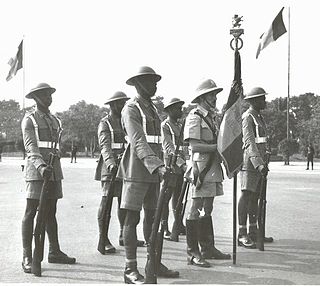
The Force Publique was the military of the Congo Free State and the Belgian Congo from 1885 to 1960. It was established after Belgian Army officers travelled to the Free State to found an armed force in the colony on Leopold II of Belgium's orders. The Force Publique was heavily involved in atrocities in the Congo Free State, and also saw action in the Congo Arab war, World War I and World War II. It was renamed to the Congolese National Army in July 1960 after Congo gained independence from Belgian colonial rule.
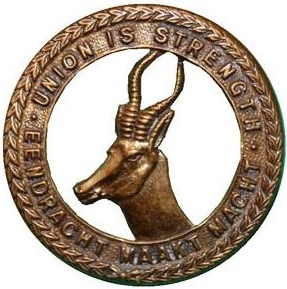
The South African Overseas Expeditionary Force (SAOEF) was a volunteer military organisation in World War I.

The Chinese Labour Corps was a labour corps recruited by the British government in the First World War to free troops for front line duty by performing support work and manual labour. The French government also recruited a significant number of Chinese labourers, and although those labourers working for the French were recruited separately and not part of the CLC, the term is often used to encompass both groups. In all, some 140,000 men served for both British and French forces before the war ended and most of the men were repatriated to China between 1918 and 1920.

Wang Jungzhi was a Chinese labourer, who was one of the last people to be executed by the British Army during the First World War. He was convicted of murder and executed by firing squad on 8 May 1919, six months after the Armistice.

The British West Indies Regiment (BWIR) was a unit of the British Army during the First World War, formed of volunteers from British colonies in the West Indies. The regiment was fifteen thousand strong, with fifteen hundred losing their life in the war.
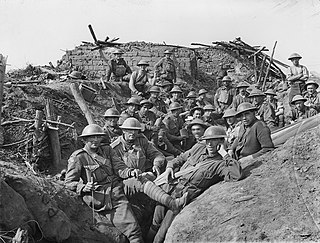
The 50th Battalion was an infantry battalion of the Australian Army. It was originally raised in Egypt in early 1916 for service during World War I, drawing a cadre of experienced personnel from the 10th Battalion. After the unit's formation, it was transferred to Europe where it took part in the fighting in the trenches of the Western Front in France and Belgium. Following the end of hostilities, the battalion was amalgamated with the 51st Battalion in early 1919 as demobilisation reduced the numbers in both battalions. In the inter war period, the battalion was briefly reformed in 1921 as a part-time unit based initially in South Australia and then later in Tasmania. At different periods it was amalgamated with both the 10th and 12th Battalions. The battalion did not see combat during World War II, being employed as garrison troops in Australia instead, and it was disbanded in mid-1945.
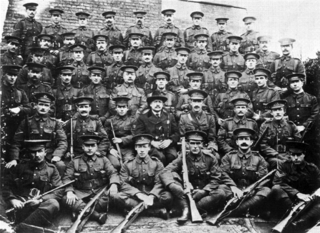
In August 1914, the United Kingdom declared war on the German Empire at the start of World War I. The settler society in Southern Rhodesia, then administered by the British South Africa Company, received the news with great patriotic enthusiasm. The Company administrator, Sir William Milton, wired the UK government, "All Rhodesia ... ready to do its duty". Although it supported Britain, the company was concerned about the possible financial implications for its chartered territory should it make direct commitments to the war effort, particularly at first. As a result, most of the colony's contribution to the war was made by Southern Rhodesians individually—not only those who volunteered to fight abroad, but also those who remained at home and raised funds to donate food, equipment and other supplies.

Southern Rhodesia, then a self-governing colony of the United Kingdom that was located in the now-independent Zimbabwe, entered World War II along with Britain shortly after the invasion of Poland in 1939. By the war's end, 26,121 Southern Rhodesians of all races had served in the armed forces, 8,390 of them overseas, operating in the European theatre, the Mediterranean and Middle East theatre, East Africa, Burma and elsewhere. The territory's most important contribution to the war is commonly held to be its contribution to the Empire Air Training Scheme (EATS), under which 8,235 British, Commonwealth and Allied airmen were trained in Southern Rhodesian flying schools. The colony's operational casualties numbered 916 killed and 483 wounded of all races.

The Maltese Labour Corps (MLC) was a labour unit raised in Malta during the First World War to support the British Army. It comprised two battalions of labourers and stevedores; two companies of cooks, waiters, and servants; and a company of miners. The units served at Gallipoli, Salonika, Italy, and in Turkey. There may have been a further independent labour company that served in Malta. Many of the units' commanding officers were drawn from the King's Own Royal Malta Regiment of Militia. More than 5,000 men served in the corps, with members receiving the British War Medal in bronze. In the course of their service 124 members died, at least one killed in action with many of the remainder dying during the Spanish Flu pandemic of 1918.
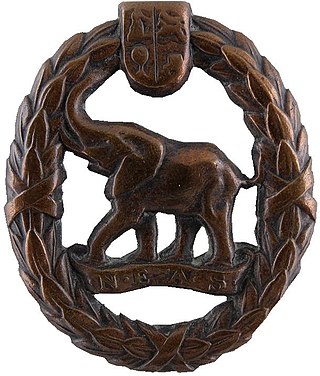
The Native Military Corps (NMC) was a South African military unit during World War II. It consisted of Black South African volunteers recruited into the Union Defence Force (UDF). Despite the unit's name, they had no combative role and served as labourers attached to white South African UDF military units. The objective was to free up the limited number of white recruits in the UDF for combat roles.

The African Auxiliary Pioneer Corps (AAPC) was a unit of the British Colonial Auxiliary Forces recruited among Africans from the High Commission Territories (HCT). It was established in July 1941, after the paramount chiefs of the HCT managed to convince the colonial authorities to create an independent force consisting of their subjects. During its service it provided crucial logistical support to the Allied war effort during the North African, Dodecanese and Italian campaigns. Initially a labor unit, AAPC's duties were gradually expanded to include anti-aircraft artillery operation and other combat duties. It was commanded by Colonel H. G. L. Prynne and numbered 36,000 men, 1,216 of whom died in the war. The last AAPC soldiers were repatriated in spring 1946 and the unit was disbanded in 1949.
South Africa's participation in the First World War occurred automatically when the British Government declared war on Germany in August 1914. Due to her status as a Dominion within the British Empire, South Africa, whilst having significant levels of self-autonomy, did not have the legal power to exercise an independent foreign policy and was tied to the British declaration.

The Indian Labour Corps was a labour corps recruited from the British Raj during World War I. Recruitment began on a voluntary basis in 1915, but by 1917 the British Government was requiring that localities provide quotas of men. The corps undertook construction duties around the world during the war with the workers frequently enduring difficult conditions. It was disbanded in 1921.

A number of alien labour units were established in the British Army's Middlesex Regiment during the First World War. The introduction of conscription of British citizens in 1916 led to a dilemma about what to do with the naturalized sons of enemy citizens. An instruction from the Army Council established the 30th and 31st (Works) Battalions of the Middlesex Regiment to take these men. These units would provide labour only and not serve in combat like the Labour Corps but were distinct from it.



















